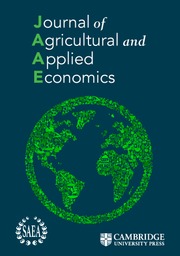No CrossRef data available.
Article contents
Simulating the Impact of Input-Price Inflation on Farm Income
Published online by Cambridge University Press: 28 April 2015
Extract
A 1964 survey of 500 wheat producers in Oklahoma and Kansas revealed that the cost-price squeeze is most commonly viewed by farmers as the major cause of chronically low farm income.The cost side of the squeeze is widely attributed to the wage-price spiral caused by cycles of wage and input price increases negotiated between labor unions and imperfectly competitive firms, and to rising taxes and interest rates.
- Type
- Research Article
- Information
- Copyright
- Copyright © Southern Agricultural Economics Association 1971
References
1.Clawson, Marion, Policy Directions for U. S. Agriculture: Long-Range Choices in Farming and Rural Living, pp. 228–243, Published for Resources for the Future, Inc., by The Johns Hopkins Press, Baltimore, Maryland, 1968.Google Scholar
2.Tweeten, Luther G., “The Demand for United States Farm Output,” Food Research Institute Studies, Vol. VII, No. 3, Stanford University, 1967.Google Scholar
3.Tweeten, Luther G., “Economic Factors Affecting Farm Policy in the 1970's.” A Review of Agriculture Policy, API No. 43, pp. 1–35, Agricultural Policy Institute, North Carolina State University, 1970.Google Scholar
4.Tweeten, Luther G. and Quance, C. Leroy, “Positivistic Measures of Aggregate Supply Elasticities: Some New Approaches,” Amer. J. of Agr. Econ., Vol. 51, No. 2, May 1969.CrossRefGoogle Scholar
5.Tweeten, Luther G. and Quance, C. Leroy, “The Impact of Input-Price Inflation on Cost and Revenue of the United States Farming Industry,” Dept. of Agr. Econ., AGEC 7101, Oklahoma State University.Google Scholar
6.U. S. Department of Agriculture, “Changes in Farm Production and Efficiency,” Stat. Bui. 233, Washington, June 1969 (and previous issues).Google Scholar


